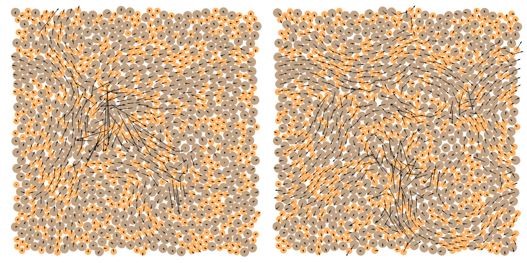New properties of glass modeled by a jammed packing of sphere when it approaches an instability has been found by XU Ning from USTC, Andrea J.Liu(University of Pennsylvania) and Sidney R. Nagel(University of Chicago) . The research shows that instabilities produce a contribution to both the density of vibrational states and the distribution of energy barriers. Their results lead to a refined understanding of marginal stability in jammed packings. The research was published in Physical Review Letters.
Disordered solids such as glasses are in very high-dimensional rugged energy landscape with metastable minima. Glass ages as time goes by which indicates the glass system moves in the energy landscape as a result of thermal excitation, compression and so forth. Due to the vast number of metastable minima, however, to predict how system evolves neither by theoretical nor computational methods is pretty challenging.

The displacement field of two-dimensional Jammed Solid under compression (Left) and shear (Right)
XU and his collaborators focus on instabilities in zero-temperature where a potential-energy barrier vanishes along some direction in configurational space to simplify this problem. They choose the easiest situation zero-temperature jammed sphere packing as their object. Jammed packings are packings where the particles are packed tightly and cannot move freely due to the impenetrability constraints.
They first simulate the scaling of the lowest vibrational mode frequency and barrier height as the system is compressed or sheared towards the stress. The simulation is accurately in line with theoretical predictions named as fold instabilities. They further study density of states and energy barriers based on the distribution functions. It turns out that both compression and shear instabilities give rise to a cube of frequency contribution to the density.
They analyzed that a finite-sized jammed solid is nearly marginally stable with respect to compression or shear and becomes marginally stable in the thermodynamic limit. In that limit an infinitesimal increase in either stress will lead to an instability and the vanishing of a mode frequency.
One interesting conclusion from their results is that the nature of the ground states in jammed systems has universal anharmonic as well as harmonic properties. Harmonic properties such as the elastic moduli and density of vibrational states are universal in jammed packings of particles with repulsive, finite-ranged potentials and the existence of universal anharmonic features has previously been hinted at in jammed systems. The anharmonic features studied here, however, are likely to be even more broadly universal because they originate from the scaling of the fold instability. This may provide the classical interpretation of abnormal heat capacity of glass at low temperature.
This work was supported by the National Natural Science Foundation of China Grants No. 21325418 and No. 11574278
Contact:
Prof. XU Ning
CAS Key Laboratory of Soft Matter Chemistry, Hefei National Laboratory for Physical Sciences at the Micro scale, and Department of Physics, University of Science and Technology of China, Hefei 230026, PR China
ningxu@ustc.edu.cn
(LYU Jinghao, USTC News Center)